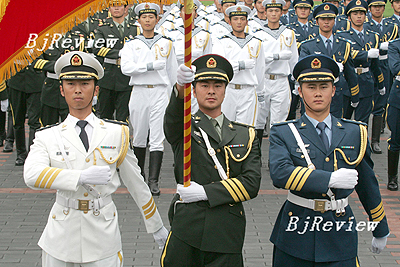
Weeks before August 1 this year, the 80th anniversary of the Chinese People's Liberation Army (PLA), China witnessed its largest-ever "fashion show" as the country rolled out sleeker uniforms for its 2.3 million-member military, prompted by a bigger budget and growing involvement in UN peacekeeping.
Brand new ceremonial and casual uniforms, as well as new battle fatigues were unveiled in Hong Kong on July 1, the 10th anniversary of Hong Kong's return to China, unleashing a loud hurrah from the mainland's enlisted men.
The uniform style of the People's Liberation Army (PLA), which used to be plain and baggy, had barely changed in more than two decades since China opened itself and launched unprecedented social and economic reform at the end of last century.
Different from the "97 Style" uniforms issued to garrison troops in Hong Kong and Macao, this army dress upgrade will allow the mainland's enlisted to cast off the baggy uniforms and look even sharper than the garrison troops in Hong Kong and Macao.
Dubbed "07 Style," the latest uniforms, which cost a total of 6 billion yuan, adopt the growing international trend of "cold colors." The ground forces will be in pine green, the navy in dark blue and the air force in deep blue-grey. The new uniforms also remove clashing elements such as scarlet hat bands and have new insignia designed to blend with the overall shade.
Besides the change of colors, berets have been introduced as standard-issue summer headgear, reminiscent of the NATO look, while Navy rank badges move down from the shoulders to the sleeves in line with international practice and women's heels will rise by 0.4 inches to 2 inches.
Traditional decorations and insignia will remain, however, including the national flag, the PLA flag, and images of the Great Wall and Tiananmen Square.
"Increasing global military exchanges have upped the requirements for PLA uniforms. The new outfits fuse global trends with Chinese characteristics," said General Liao Xilong, Chief of the PLA's General Logistics Department, when meeting the press in July.
The PLA uniform has undergone a series of redesigns since the military's birth. With the "97 Style," designers refined the cut and the sizing of the uniforms to enhance the appearance of the wearers. The new casual uniform for spring and autumn fits more tightly because it has been taken in at the chest and waist.
The focus of the designers was to improve aesthetics, quality and functionality of military outfits, said Yang Tingxin, head of the Quartermaster Equipment Institute (QEI) responsible for the uniform designs. "It would be impossible to carry out such a major upgrade if the country's economic strength hadn't grown rapidly," he said.
Technological and financial constraints meant that up until 1987 Chinese forces were only issued one uniform for working, field surveys and training when casual uniforms were first introduced.
"Letter H uniforms have been ditched once and for all, they're a thing of the past," said Wu Yu, a QEI senior engineer. "Now we have letter T uniforms for men and letter X for women."
The H-shaped uniforms appear baggy and dull compared with military uniforms from other countries. Men in T-shaped uniforms that highlight shoulder breadth look taller and stronger; women in X-shaped uniforms featuring contracted waists are much sassier, Wu explained.
After three years of study, designers made more than 100 refinements to the "97 Style" and introduced 365 new items including sweaters, training boots, gloves, socks, training overcoats and apparel such as arm badges, name patches and service insignia.
"My impression is that the top leaders of the military really want to make the rank-and-filers look smart and feel comfortable. They are very open-minded," said Yang Tingxin, who was involved in the design of "87 Style."
New Logistics Concept
This year, many ceremonial uniforms have come direct from factory production lines. Delivered on clothes hangers, they are without a single wrinkle and have the name label of the wearer stitched on.
"This military dress upgrade is a stride forward in the PLA's logistics management," said Wang Zongxi, Professor at the PLA Logistics Command Institute.
Manufacturers that won contracts to produce the new ceremonial uniforms have been required to take the measurements of the country's 2.3 million military. This massive undertaking has made it possible to deliver tailor-made uniforms to every eligible wearer direct from factories to barracks.
Liao said that the Army would no longer keep inventory and no longer be involved in inventory management for ceremonial uniforms. "The idea is to outsource inventory management of these uniforms to private firms and slash our storage costs."
In February, the Chinese military authorities urged military areas and units to collaborate more with civil enterprises in order to improve logistics management.
"A uniform upgrade is not just about looking 'snappy'. It is part of a whole system of logistics. The new design concept, new materials and new technologies improve uniform quality but they are also hooked into optimized management of bedding and clothing," Liao said. | 